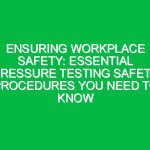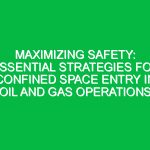In the realm of Health Safety and Environment (HSE), ensuring the integrity and safety of pipelines is paramount. The catastrophic consequences of pipeline failures, including environmental disasters, loss of life, and economic losses, underscore the critical importance of adopting best practices for pipeline integrity and inspection. This article delves into the essential strategies and technologies that can be employed to enhance pipeline safety, thereby safeguarding both human lives and the environment.
Understanding Pipeline Integrity Management
Pipeline Integrity Management (PIM) is a comprehensive approach that encompasses various practices aimed at ensuring pipelines operate safely, reliably, and compliantly. At its core, PIM involves regular inspections, maintenance, and the implementation of safety measures to prevent pipeline failures.
The Role of Risk Assessment
A pivotal component of PIM is conducting thorough risk assessments. These assessments help identify potential hazards that could compromise pipeline integrity, such as corrosion, mechanical damage, and natural forces. By understanding these risks, companies can prioritize maintenance and inspection efforts where they are most needed.
Technological Innovations in Pipeline Inspection
Advancements in technology have revolutionized pipeline inspections, making them more accurate and less intrusive. Techniques such as Magnetic Flux Leakage (MFL), Ultrasonic Testing (UT), and Smart Pigging allow for the detailed assessment of pipeline conditions without disrupting operations. These technologies enable the early detection of issues such as cracks, corrosion, and wall thickness reductions.
Best Practices for Pipeline Integrity and Inspection
To maximize safety in the HSE field, adopting a set of best practices for pipeline integrity and inspection is essential. These practices not only ensure compliance with regulations but also significantly reduce the risk of pipeline incidents.
Regular Maintenance and Inspections
Consistent maintenance and regular inspections are the bedrock of pipeline safety. Scheduled checks allow for the timely identification and rectification of potential issues before they escalate into major problems. Employing both traditional and advanced inspection methods ensures a comprehensive understanding of pipeline health.
Corrosion Protection Measures
Corrosion is a leading cause of pipeline degradation. Implementing corrosion protection measures, such as cathodic protection, coating pipelines with corrosion-resistant materials, and adding corrosion inhibitors to the transported products, can significantly extend the lifespan of pipelines.
Emergency Response Planning
Despite the best preventive measures, emergencies can still occur. Having a well-defined and regularly practiced emergency response plan is crucial. This plan should include procedures for immediate response, communication protocols, and strategies for minimizing environmental impact.
Training and Awareness
Ensuring that all personnel involved in pipeline operations are adequately trained and aware of safety protocols is fundamental. Regular training sessions, safety drills, and awareness programs help foster a culture of safety and preparedness among the workforce.
Utilizing Data and Analytics
The integration of data analytics into pipeline integrity management offers a proactive approach to pipeline maintenance. By analyzing data collected from inspections and sensors, companies can predict potential failures and take preemptive action. This data-driven approach enhances decision-making and resource allocation for maintenance activities.
Regulatory Compliance and Continuous Improvement
Adhering to national and international regulations governing pipeline safety is not just a legal requirement but also a moral obligation. Continuous improvement through the adoption of industry best practices, learning from past incidents, and staying abreast of technological advancements ensures that pipeline operations remain safe and efficient.
Engaging with Stakeholders
Engagement with local communities, environmental groups, and regulatory bodies is essential for the successful management of pipeline integrity. Transparent communication and collaboration can help address concerns, foster trust, and ensure that safety measures are understood and supported by all stakeholders.
Conclusion: A Commitment to Safety
Maximizing safety in pipeline operations within the HSE field requires a multifaceted approach that encompasses rigorous inspections, regular maintenance, technological innovation, and a strong culture of safety. By implementing the best practices for pipeline integrity and inspection outlined in this article, companies can significantly mitigate risks, protect the environment, and ensure the safety of communities and workers alike.
Remember, the integrity of pipelines is not just about preventing leaks or failures; it’s about safeguarding our future. Through diligent management, continuous improvement, and a commitment to safety, we can achieve the highest standards of pipeline integrity and inspection in the HSE field.
Summary of Key Points
- Pipeline Integrity Management is crucial for safe and reliable pipeline operations.
- Technological advancements have enhanced the accuracy and efficiency of pipeline inspections.
- Best practices include regular maintenance, corrosion protection, emergency planning, and regulatory compliance.
- Training, data analytics, and stakeholder engagement play vital roles in maintaining pipeline integrity.
- A commitment to continuous improvement and safety culture is essential for maximizing pipeline safety.


